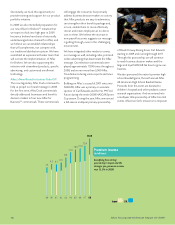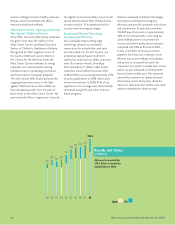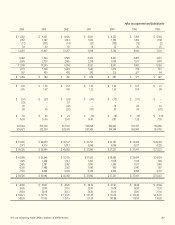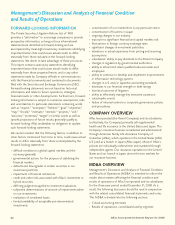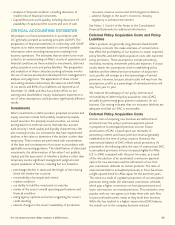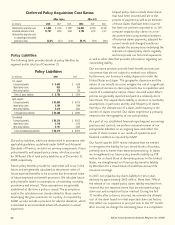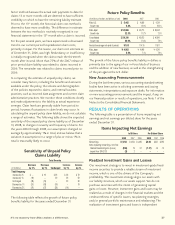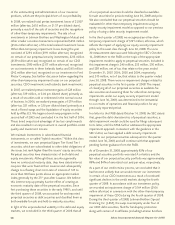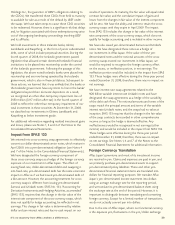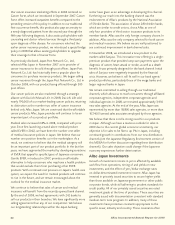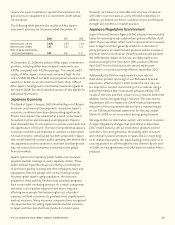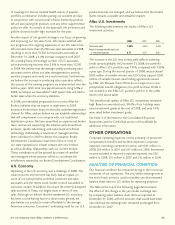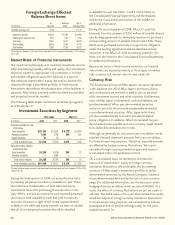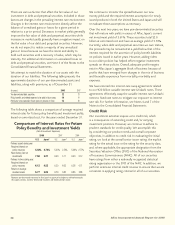Aflac 2008 Annual Report Download - page 32
Download and view the complete annual report
Please find page 32 of the 2008 Aflac annual report below. You can navigate through the pages in the report by either clicking on the pages listed below, or by using the keyword search tool below to find specific information within the annual report.
28 Aflac Incorporated Annual Report for 2008
of the underwriting and administration of our insurance
products, which are the principal drivers of our profitability.
In 2008, we realized total pretax investment losses of $1,007
million (after-tax, $655 million, or $1.37 per diluted share),
primarily a result of the sale of securities and the recognition
of other-than-temporary impairments. The sale of our
investments in Lehman Brothers and Washington Mutual and
other smaller securities transactions represented $254 million
($166 million after-tax) of the total realized investment losses.
Other-than-temporary impairment losses during the year
consisted of $294 million ($191 million after-tax) recognized
on certain of our perpetual security investments; $213 million
($139 million after-tax) recognized on certain of our CDO
investments; $180 million ($117 million after-tax) recognized
on our investments in three Icelandic banks; and $65 million
($42 million after-tax) recognized on our investment in Ford
Motor Company. See further discussion below regarding the
other-than-temporary impairment losses on our perpetual
securities, CDO investments and Icelandic bank investments.
In 2007, we realized pretax investment gains of $28 million
(after-tax, $19 million, or $.04 per diluted share) primarily as
a result of securities sold or redeemed in the normal course
of business. In 2006, we realized pretax gains of $79 million
(after-tax, $51 million, or $.10 per diluted share) primarily as a
result of bond swaps and the liquidation of equity securities
held by Aflac U.S. We began a bond-swap program in the
second half of 2005 and concluded it in the first half of 2006.
These bond swaps took advantage of tax loss carryforwards
and also resulted in an improvement in overall portfolio credit
quality and investment income.
We maintain investments in subordinated financial
instruments, or so-called “hybrid securities.” Within this class
of investments, we own perpetual Upper Tier II and Tier I
securities, which are subordinated to other debt obligations of
the issuer, but rank higher than the issuers’ equity securities.
Perpetual securities have characteristics of both debt and
equity investments. Although these securities generally
have no contractual maturity date, they have stated interest
coupons that were fixed at their issuance and subsequently
change to a floating short-term rate of interest of 125 to
more than 300 basis points above an appropriate market
index, generally by the 25th year after issuance. We believe
this interest step-up penalty has the effect of creating an
economic maturity date of the perpetual securities. Since
first purchasing these securities in the early 1990’s, and until
the third quarter of 2008, we accounted for and reported
perpetual securities as debt securities and classified them as
both available-for-sale and held-to-maturity securities.
In light of the unprecedented volatility in the debt and equity
markets, we concluded in the third quarter of 2008 that all
of our perpetual securities should be classified as available-
for-sale securities for periods ending June 30, 2008 and prior.
We also concluded that our perpetual securities should be
evaluated for other-than-temporary impairments using an
equity security impairment model as opposed to our previous
policy of using a debt security impairment model.
In the third quarter of 2008, we recognized an other-than-
temporary impairment charge of $191 million, after-tax, which
reflects the impact of applying our equity security impairment
policy to this asset class through June 30, 2008. The June
30 measurement date was used following the SEC’s October
14, 2008 letter to the FASB on the topic of the appropriate
impairment model to apply to perpetual securities. Included in
this impairment charge is $40 million, $53 million, $50 million,
and $38 million, net of tax, that relate to the years ended
December 31, 2007, 2006, 2005 and 2004, respectively;
and, $10 million, net of tax, that relates to the quarter ended
June 30, 2008. There were no impairment charges related to
perpetual securities in the first quarter of 2008. The impact
of classifying all of our perpetual securities as available-for-
sale securities and assessing them for other-than-temporary
impairments under our equity security impairment model
through June 30, 2008, was determined to be immaterial
to our results of operations and financial position for any
previously reported period.
In a letter to the FASB dated October 14, 2008, the SEC stated
that, given the debt characteristics of perpetual securities, a
debt impairment model could be used for filings subsequent
to its letter, until the FASB further addresses the appropriate
impairment approach. Consistent with the guidance in the
SEC’s letter, we have applied a debt security impairment
model to our perpetual securities subsequent to the quarter
ended June 30, 2008, and will continue with that approach
pending further guidance from the FASB.
As of December 31, 2008, approximately 92% of our
perpetual securities portfolio was rated A or better, and the
fair value of our perpetual security portfolio was approximately
89% and 84% of amortized cost and par value, respectively.
As a part of our credit review process, we concluded that it
had become unlikely that we would recover our investment
in certain of our CDO investments as a result of continued
significant declines in the credit markets during the fourth
quarter of 2008. In accordance with our investment policy,
we recorded an impairment charge of $164 million ($106
million after-tax) in connection with the other-than-temporary
impairment of these CDOs during the fourth quarter of 2008.
During the third quarter of 2008, Lehman Brothers Special
Financing Inc. (LBSF), the swap counterparty under four of
our CDO debt securities, filed for bankruptcy protection
along with certain of its affiliates (including Lehman Brothers


